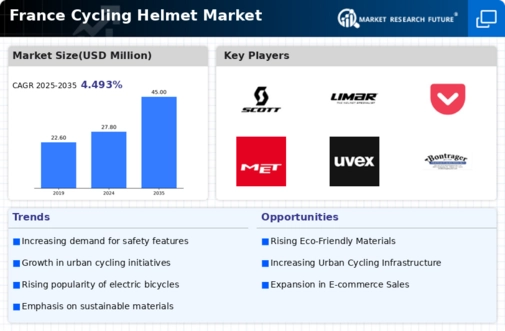Government Initiatives and Subsidies
Government initiatives aimed at promoting cycling as a sustainable mode of transport are likely to bolster the cycling helmet market in France. Various local and national programs provide subsidies for purchasing bicycles and safety gear, including helmets. For instance, recent policies have allocated approximately €10 million to support cycling infrastructure and safety equipment. Such financial incentives encourage more individuals to adopt cycling, thereby increasing the potential customer base for the cycling helmet market. As these initiatives continue to gain momentum, the market may experience a surge in demand, particularly among new cyclists who are incentivized to invest in safety gear.
Growing Urban Cycling Infrastructure
The expansion of urban cycling infrastructure in France appears to be a pivotal driver for the cycling helmet market. As cities invest in dedicated bike lanes and cycling-friendly facilities, the number of cyclists is likely to increase. This trend is supported by data indicating that cycling participation in urban areas has risen by approximately 15% over the past few years. Consequently, the demand for helmets is expected to grow, as safety becomes a priority for both new and experienced cyclists. The cycling helmet market is thus positioned to benefit from this infrastructural development, as more individuals take to the streets on bicycles, necessitating protective gear to enhance safety and compliance with regulations.
Increased Awareness of Cycling Safety
There is a notable rise in public awareness regarding cycling safety in France, which significantly influences the cycling helmet market. Campaigns promoting helmet use and the dangers of cycling without proper headgear have gained traction, leading to a cultural shift towards prioritizing safety. Recent surveys indicate that approximately 70% of cyclists now wear helmets regularly, compared to 50% a few years ago. This heightened awareness is likely to drive sales in the cycling helmet market, as consumers become more informed about the risks associated with cycling. As safety becomes a societal norm, manufacturers may also respond by innovating and diversifying their product offerings to meet the evolving demands of safety-conscious cyclists.
Rising Popularity of Recreational Cycling
The increasing popularity of recreational cycling in France is likely to have a positive impact on the cycling helmet market. More individuals are engaging in cycling for leisure, fitness, and social activities, leading to a broader demographic of potential helmet users. Data suggests that recreational cycling participation has surged by around 20% in recent years, indicating a shift in lifestyle choices among the population. This trend is expected to drive demand for helmets, as recreational cyclists prioritize safety while enjoying their rides. The cycling helmet market stands to benefit from this growing interest, as manufacturers may tailor their products to cater to the diverse needs of recreational cyclists.
Technological Innovations in Helmet Design
Technological advancements in helmet design are emerging as a crucial driver for the cycling helmet market. Innovations such as lightweight materials, improved ventilation systems, and enhanced impact resistance are attracting consumers who seek both safety and comfort. The introduction of smart helmets equipped with features like Bluetooth connectivity and built-in lights is also gaining popularity. These advancements not only enhance the user experience but also align with the growing trend of integrating technology into everyday products. As the cycling helmet market evolves, manufacturers that prioritize research and development are likely to capture a larger share of the market, appealing to tech-savvy cyclists who value modern features.






















Leave a Comment